
This book "Anacalypsis" that we are about to analyze, was written in the early 1830's. It is particularly important to Black people, not only because it confirms that the Albinos knew, and tried to cover-up, the fact that the original people, civilizations, and creators of all of mans original accomplishments on this Earth, were Black People. But also because of WHO the writer so innocently identifies as Black: (The Greeks - the supposed cornerstones of western civilization). The book also demonstrates just how recent this business of "writing Blacks out of history" really is. Most of us assume that Albino Europeans started to eradicate Blacks from history immediately after the "Thirty Years" War on the continent, and after the Civil Wars in Britain - which were "Race Wars" about eradicating Blacks from Europe physically. But here we have a British author "Matter-of-Factly" listing all the important Ancients: (those responsible for the creation of all things relating to Civilization) as Blacks, as late as the early 1800s. By this time in the Americas, the Genocide of Native American Blacks was near completion, that is why Mr. Higgins could only speak of Black tribes in South America, and not the dominance of Blacks in the Americas. And the book also shows that it was at about this time, when they (the Albinos) started to wonder where THEY, as the unusual White Humans they are, fit in.
We see the writer Godfrey Higgins, musing about all manner of combinations and occurrences which would explain the existence of White people - or the Pink and White as he and Benjamin Franklin like to call their people. And true to form, the only solution that he can come up with is that their delicacy and limited range on the Earth, is proof of their HIGHER evolution. And of course to his thinking, the strong Blacks must be the earlier and more primitive form of human. Oh what beautiful self-serving logic the Albinos come up with: Nature works backwards - it evolves from the strongest and most perfect, to the weakest and most defective - how absurd. And isn't it funny how the simplest and most obvious explanation for White People - ALBINISM - is never mentioned.
Naturally, as word gets out that we have discovered this book, and seized upon it as proof of the assertions which are the foundation of this Website: the Albinos will begin a campaign to discredit the book and it's writer. Accordingly, we will state Mr. Higgins credentials, and as Mr. Higgins cites an ancient people as Black, we will support that with artifacts for those particular peoples, from the related section on our Website - see the main menu.
Anacalypsis (full title: Anacalypsis: An Attempt to Draw Aside the Veil of the Saitic Isis or an Inquiry into the Origin of Languages, Nations and Religions) is a lengthy two-volume treatise written by religious historian Godfrey Higgins, and published after his death in 1836. The book was published in two quarto volumes numbering 1,436 pages, and contains meticulous references to hundreds of references. Initially printed as a limited edition of 200 copies, it was partially reprinted in 1878, and completely reprinted in a limited edition of 350 copies in 1927. In 1965, University Books, Inc. published 500 sets for the United States and 500 sets for the British Commonwealth with Publisher's Note and a Postface.
The work is the product of more than twenty years of research, during which Higgins tried to uncover "a most ancient and universal religion from which all later creeds and doctrines sprang". It includes several maps and lithographic plates of Druidical Monuments. The book itself details many of Higgins' beliefs and observations about the development of religion. Among these was his theory that a secret religious order, which he labeled "Pandeism" (from Pans- or Pandu- referring to a family of Gods, appending with -ism), had continued from ancient times to the present day, stretching at least from Greece to India, and possibly having once covered the entire world:
"All this seems to confirm the very close connexion which there must have been in some former time, between Siam, Afghanistan, Western Syria, and Ireland. Indeed I cannot doubt that there has been really one grand empire, or one Universal, one Pandæan, or one Catholic religion, with one language, which has extended over the whole of the world; uniting or governing at the same time..."
Among the many unusual theories presented in this book is that both the Celtic Druids and the Jews originated in India – and that the name of the Biblical Abraham is really a variation of the word Brahma, created by shifting the last letter to the beginning: Abrahma.
 |
Godfrey Higgins (January 30, 1772 in Owston, Yorkshire — August 9, 1833 in Cambridge) was an English magistrate and landowner, a prominent advocate for social reform, historian, and antiquarian. He is now best known for his writings on ancient myths, especially his posthumously published book Anacalypsis, in which he asserts a commonality among various religious myths, which he traces back to the supposed lost religion of Atlantis. He has been called a "political radical, reforming county magistrate and idiosyncratic historian of religions".
Godfrey Higgins was a well though-of, and well respected Historian. Higgins was a Fellow of the Society of Antiquaries: The Society of Antiquaries of London (SAL) is a learned society "charged by its Royal Charter of 1751 with 'the encouragement, advancement and furtherance of the study and knowledge of the antiquities and history of this and other countries'. Higgins' main writings took part in the syncretist thinking of the day, which attempted to link Biblical narratives to evidence emerging about other religious traditions. Higgins discussed, and argued with, other authors in this tradition such as Jacob Bryant, Roger O'Connor and William Jones.
Homer is best known as the author of the "Iliad" and the "Odyssey". He was believed by the ancient Greeks to have been the first and greatest of the epic poets. Author of the first known literature of Europe, he is central to the Western canon.
When he lived, as well as whether he lived at all, is unknown. Herodotus estimates that Homer lived no more than 400 years before his own time, which would place him at around 850 BCE or later. Pseudo-Herodotus estimates that he was born 622 years before Xerxes I placed a pontoon bridge over the Hellespont in 480 BCE, which would place him at 1102 BCE, 168 years after the fall of Troy in 1270 BCE. These two end points are 252 years apart, representative of the differences in dates given by the other sources.
The importance of Homer to the ancient Greeks is described in Plato's "Republic", which portrays him as the protos didaskalos, "first teacher", of the tragedians, the hegemon paideias, "leader of Greek culture", and the ten Hellada pepaideukon, "teacher of [all] Greece". Homer's works, which are about fifty percent speeches, provided models in persuasive speaking and writing that were emulated throughout the ancient and medieval Greek worlds. Fragments of Homer account for nearly half of all identifiable Greek literary papyrus finds in Egypt.
The Iliad in Classical Attic; sometimes referred to as the Song of Ilion or Song of Ilium) is an ancient Greek epic poem in dactylic hexameter, traditionally attributed to Homer. Set during the Trojan War, the ten-year siege of the city of Troy (Ilium) by a coalition of Greek states, it tells of the battles and events during the weeks of a quarrel between King Agamemnon and the warrior Achilles.
Although the story covers only a few weeks in the final year of the war, the Iliad mentions or alludes to many of the Greek legends about the siege; the earlier events, such as the gathering of warriors for the siege, the cause of the war, and related concerns tend to appear near the beginning. Then the epic narrative takes up events prophesied for the future, such as Achilles' looming death and the sack of Troy, prefigured and alluded to more and more vividly, so that when it reaches an end, the poem has told a more or less complete tale of the Trojan War.
The Iliad is paired with something of a sequel, the Odyssey, also attributed to Homer. Along with the Odyssey, the Iliad is among the oldest extant works of Western literature, and its written version is usually dated to around the eighth century BC. Recent statistical modelling based on language evolution gives a date of 760–710 BC. In the modern vulgate (the standard accepted version), the Iliad contains 15,693 lines; it is written in Homeric Greek, a literary amalgam of Ionic Greek and other dialects.
The Odyssey is one of two major ancient Greek epic poems attributed to Homer. It is, in part, a sequel to the Iliad, the other work ascribed to Homer. The poem is fundamental to the modern Western canon, and is the second oldest extant work of Western literature, the Iliad being the oldest. Scholars believe it was composed near the end of the 8th century BC, somewhere in Ionia, the Greek coastal region of Anatolia.
The poem mainly focuses on the Greek hero Odysseus (known as Ulysses in Roman myths) and his journey home after the fall of Troy. It takes Odysseus ten years to reach Ithaca after the ten-year Trojan War. In his absence, it is assumed he has died, and his wife Penelope and son Telemachus must deal with a group of unruly suitors, the Mnesteres or Proci, who compete for Penelope's hand in marriage.
 |
Etruria (usually referred to in Greek and Latin source texts as Tyrrhenia) was a region of Central Italy, located in an area that covered part of what are now Tuscany, Lazio, and Umbria. The ancient people of Etruria are labelled Etruscans, and their complex culture was centered on numerous city-states that rose during the Villanovan period in the ninth century BC and were very powerful during the Orientalizing Archaic periods. The Etruscans were a dominant culture in Italy by 650 BC, surpassing other ancient Italic peoples such as the Ligures, and their influence may be seen beyond Etruria's confines in the Po River Valley and Latium, as well as in Campania and through their contact with the Greek colonies in Southern Italy (including Sicily). Indeed, at some Etruscan tombs, such as those of the Tumulus di Montefortini at Comeana (see Carmignano) in Tuscany, physical evidence of trade has been found in the form of grave goods—fine faience ware cups are particularly notable examples. Such trade occurred either directly with Egypt, or through intermediaries such as Greek or Etruscan sailors.
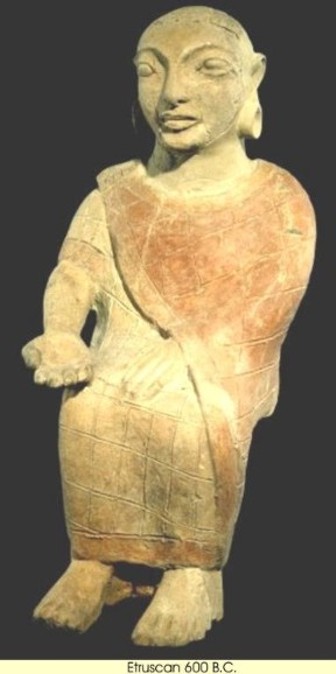 |
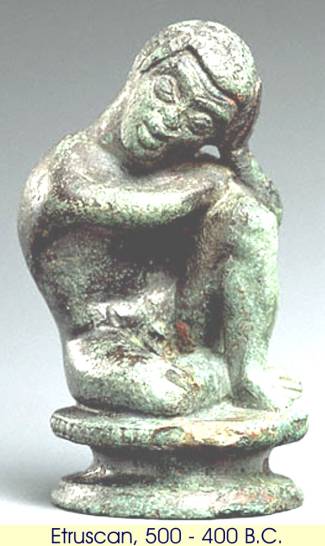 |
Rome, buffered from Etruria by the Silva Ciminia, the Ciminian Forest, was influenced strongly by the Etruscans, with a series of Etruscan kings ruling at Rome until 509 BC when the last Etruscan king Lucius Tarquinius Superbus was removed from power and the Roman Republic was established. The Etruscans are credited with influencing Rome's architecture and ritual practice; it was under the Etruscan kings that important structures such as the Capitolium, Cloaca Maxima, and Via Sacra were realized. The Etruscan civilization was responsible for much of the Greek culture imported into early Republican Rome, including the twelve Olympian gods, the growing of olives and grapes, the Latin alphabet (adapted from the Greek alphabet), and architecture like the arch, sewerage and drainage systems.
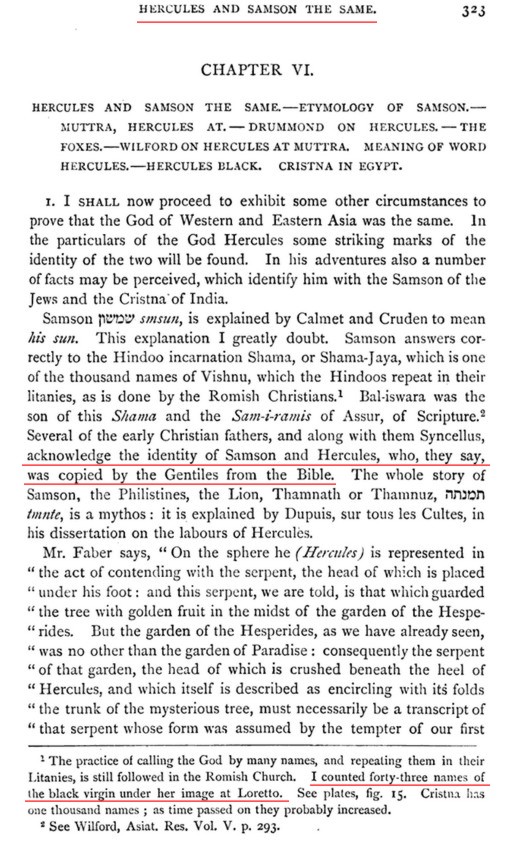 |
 |
 |
Krishna is a Hindu deity, worshipped across many traditions of Hinduism in a variety of different perspectives. Krishna is recognized as the complete and eighth avatar of the God Vishnu or as the Supreme God in own right. Krishna is one of the most widely revered and popular of all Hindu deities. Krishna known via many names such as Kishan,Makhanchor, Kanha. Krishna is often described and portrayed as an infant eating butter, a young boy playing a flute as in the Bhagavata Purana, a young man along with Radha or as an elder giving direction and guidance as in the Bhagavad Gita. The stories of Krishna appear across a broad spectrum of Hindu philosophical and theological traditions. They portray him in various perspectives: a god-child, a prankster, a model lover, a divine hero, and the Supreme Being. The principal scriptures discussing Krishna's story are the Mahabharata, the Harivamsa, the Bhagavata Purana, and the Vishnu Purana. |
 |
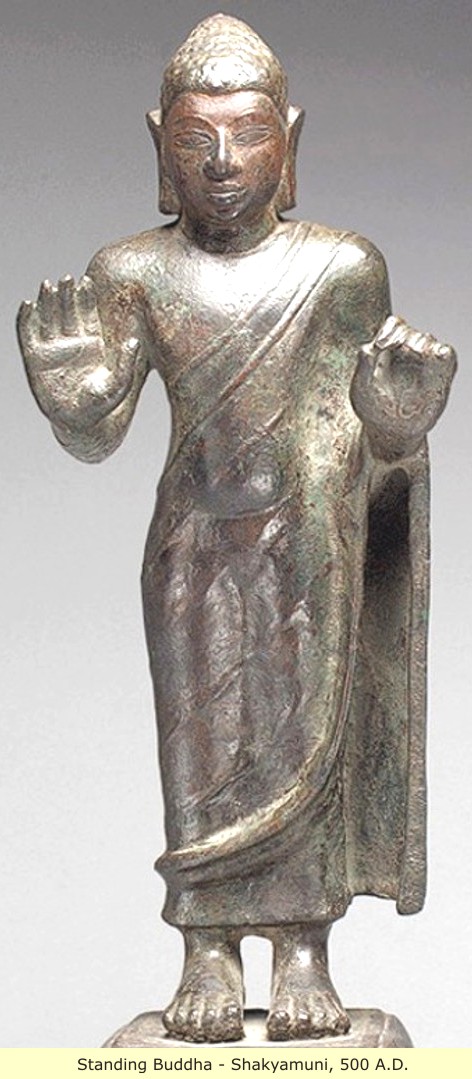 |
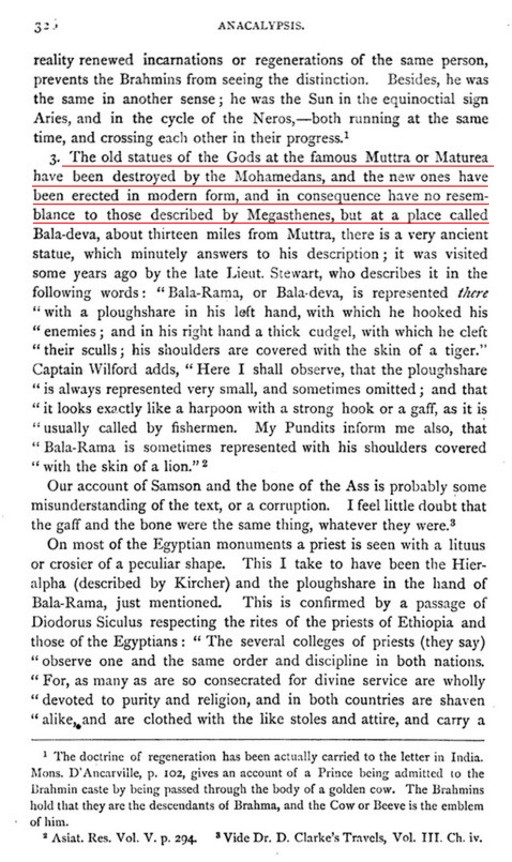 |
 |
 |
 |
 |
 |
 |
This fresco of the Good Shepherd was found on the ceiling of the Vault of Lucina in the Catacomb of Callixtus in Rome. The construction of the vault itself has been dated to the second half of the 2nd century, but the use of the red and green lines to divide the space (similar to the chambers under San Sebastiano) has suggested the first half or middle of the 3rd century for this fresco. The image of Jesus as the Good Shepherd was an especially popular motif in the early Christian centuries. It was based on several biblical passages, including the 23rd Psalm and sayings of Jesus, and is also an adaptation of a popular pagan image.
 |
This fresco of the Good Shepherd was found on the ceiling of the Vault of Lucina in the Catacomb of Callixtus in Rome. The construction of the vault itself has been dated to the second half of the 2nd century, but the use of the red and green lines to divide the space (similar to the chambers under San Sebastiano) has suggested the first half or middle of the 3rd century for this fresco.
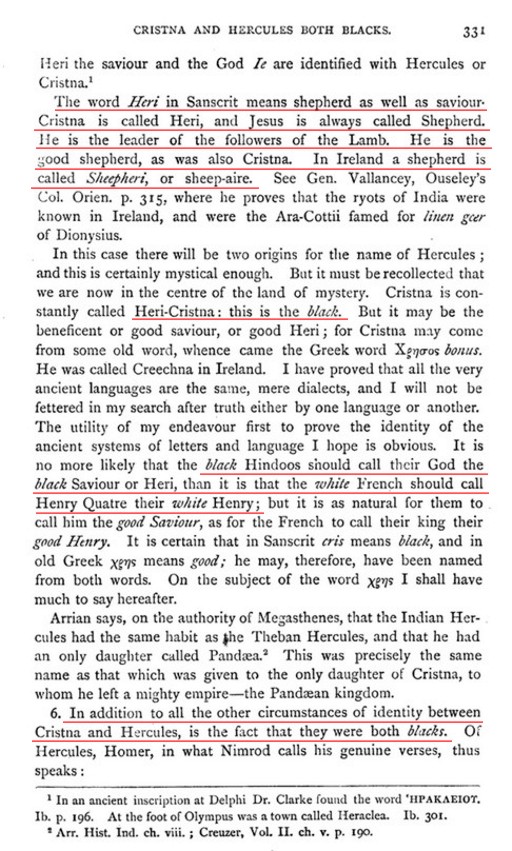 |
Godfrey Higgins statements regarding Blacks being the beginning of ALL civilizations, religions, sciences, etc, are simply statements of fact prompted by the evidences of ancient Writings and Artifacts. His statements regarding the commonality of all the major religions, was a logic gained after twenty years of research.
Godfrey Higgins correctly concluded that there was something familiar about the Christian Jesus being identified with a Lamb, and called a Shepherd: And the Black religions from thousand of years earlier.
The Hebrews were an Amorite tribe of rabble and criminals, who started migrating south from their home in Anatolia circa 2,000 B.C. They split into two groups: The first group established themselves in the Eastern Hills of Canaan, from where they attacked and harassed the Canaanites, which at this time included the Phoenicians. The second group migrated into Sumer where they were finally able to establish the dynasty of Hammurabi.
 |
It was after the Sumerians regained control of their country and kicked out the Amorites of Hammurabi: (by this time the Sumerians were known as Chaldeans), that Abraham and his Amorite family were forced to leave Sumer: (recall that Abraham was said to have left Ur of the Chaldees). But they did not leave empty-handed, they carried with them the religion they had learned in Sumer. Upon leaving Sumer, they returned home to Anatolia. And after spending some years back home in Anatolia, they moved on to Canaan.
so as to obliterate the divine powers of Sumer, to change its preordained plans, to alienate the divine powers of the reign of kingship of Urim, to humiliate the princely son in his house E-kic-nu-jal, to break up the unity of the people of Nanna, numerous as ewes; to change the food offerings of Urim, the shrine of magnificent food offerings; that its people should no longer dwell in their quarters, that they should be given over to live in an inimical place; that Cimacki and Elam, the enemy, should dwell in their place; that its shepherd, in his own palace, should be captured by the enemy, that Ibbi-Suen should be taken to the land Elam in fetters, that from Mount Zabu on the edge of the sea to the borders of Ancan, like a swallow that has flown from its house, he should never return to his city;
Its king, the shepherd Naram-Suen, rose as the daylight on the holy throne of Agade. Its city wall , like a mountain, (1 ms. has instead: , a great mountain,) reached the heavens. The building of Ning̃irsu's temple (Gudea, cylinders A and B). The mighty steward of Nanše, the accomplished shepherd of Ning̃irsu, is wise, and able too to realise things; the man in charge of building the house, Gudea the ruler of Lagaš, was to make presents for the house.
its king, shepherd Ur- Zababa, rose like Utu over the house of Kic. An and Enlil, however, authoritatively (?) decided (?) by their holy command to alter his term of reigning and to remove the prosperity of the palace.
His lady, Inana the pure, sat there on her cushion. He bowed and prostrated himself on the ground. With (1 ms. adds joyful) eyes Inana looked at Lugalbanda the pure as she would look at the shepherd Ama-ucumgal-ana .
My champion is embraced by Enlil. I shall send him such a champion. My champion will compete against his champion, and let the more able one prevail!" Say this to him. Second, speak to him and say: "Let him immediately pass from subterfuge ....... In his city, let them go before him like sheep. Let him, like their shepherd, follow behind them.
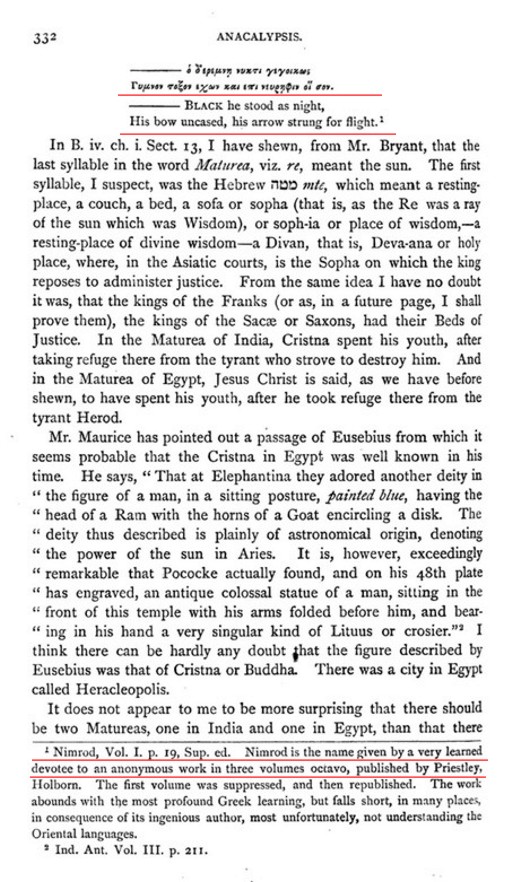 |
Break for Nimrod... |
 |
 |
Link to the harvard translation:http://catalog.hathitrust.org/Record/009724311 Anacalypsis Continued.... |
 |
 |
The Ionians were one of the four major tribes that the Greeks considered themselves divided into, during the ancient period; alongside Dorians, Aeolians and Achaeans. The Ionian dialect was one of the three major linguistic divisions of the Hellenic world, together with the Dorian and Aeolian dialects.
When referring to populations, "Ionian" defines several groups in Classical Greece. In the narrowest sense, it referred to the region of Ionia in Asia Minor. In a broader sense, it could be used to describe all speakers of the Ionic dialect, which in addition to those in Ionia proper also included the populations of Euboea, the Cyclades and many colonies founded by Ionian colonists. Finally, in the broadest sense, it could be used to describe all those who spoke languages of the East Greek group, which included Attic.
The Foundation myth which was current in the Classical period suggested that the Ionians were named after Ion, son of Xuthus, who lived in the north Peloponnesian region of Aegilaus. When the Dorians invaded the Peloponnese and expelled the Achaeans from the Argolid and Lacedaemonia, the Achaeans moved into Aegilaus (henceforth known as Achaea) and the Ionians were in turn expelled. The Ionians moved to Attica and mingled with the local population. Later, many people emigrated to the coast of Asia Minor founding the historical region of Ionia.
Unlike the austere and militaristic Dorians, the Ionians are renowned for their love of philosophy, art, democracy, and pleasure - Ionian traits that were most famously expressed by the Athenians.
The name was used by some ancient Greek writers to refer to populations that were either the ancestors of the Greeks or preceded the Greeks in Greece, "a hold-all term for any ancient, primitive and presumably indigenous people in the Greek world". In general, "Pelasgian" has come to mean more broadly all the indigenous inhabitants of the Aegean Sea region and their cultures before the advent of the Greek language.
During the classical period, enclaves under that name survived in several locations of mainland Greece, Crete, and other regions of the Aegean. Populations identified as "Pelasgian" spoke a language or languages that at the time Greeks identified as "barbaric", even though some ancient writers described the Pelasgians as Greeks. A tradition also survived that large parts of Greece had once been Pelasgian before being Hellenized. These parts generally fell within the ethnic domain that, by the 5th century BC, was attributed to those speakers of ancient Greek who were identified as Ionians.
Greeks did not always clearly distinguish the Minyans from the Pelasgian cultures that had preceded them. Greek mythographers gave the Minyans an eponymous founder, Minyas, perhaps as legendary as Pelasgus (the founding father of the Pelasgians), which was a broader category of pre-Greek Aegean peoples. These Minyans were associated with Boeotian Orchomenus, as when Pausanias relates that "Teos used to be inhabited by Minyans of Orchomenus, who came to it with Athamas" and may have represented a ruling dynasty or a tribe later located in Boeotia.
Herodotus asserts several times that Pelasgians dwelt in the distant past with the Athenians in Attica, and that those Pelasgians driven from Attica in turn drove the Minyans out of Lemnos. The same historian also states that Minyans from Amyklai settled on the island of Thera in 800 BC.
Heracles, the hero whose exploits always celebrate the new Olympian order over the old traditions, came to Thebes, one of the ancient Mycenaean cities of Greece, and found that the Greeks were paying tribute of 100 cattle (a hecatomb) each year to Erginus, king of the Minyans. Heracles attacked a group of emissaries from the Minyans, and cut off their ears, noses and hands. He then tied them around their necks and told them to take those for tribute to Erginus. Erginus made war on Thebes, but Heracles defeated the Minyans with his fellow Thebans after arming them with weapons that had been dedicated in temples. Erginus was killed and the Minyans were forced to pay double the previous tribute to the Thebans. Heracles was also credited with the burning of the palace at Orchomenus: "Then appearing unawares before the city of the Orchomenians and slipping in at their gates he burned the palace of the Minyans and razed the city to the ground."
The Argonauts were sometimes referred to as "Minyans" because Jason's mother came from that line, and several of his cousins joined in the adventure.
 |
 |
 |
 |
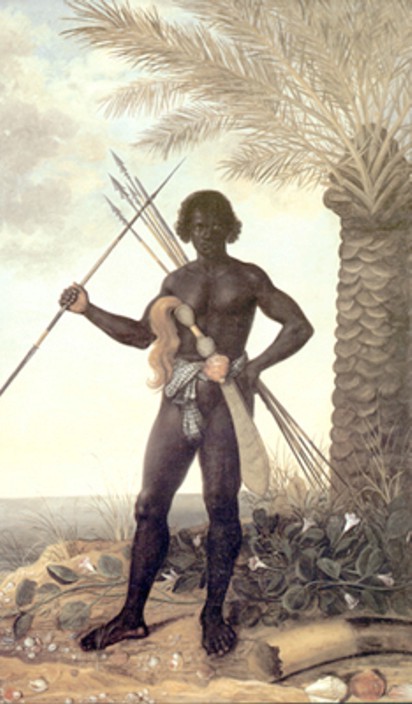 |
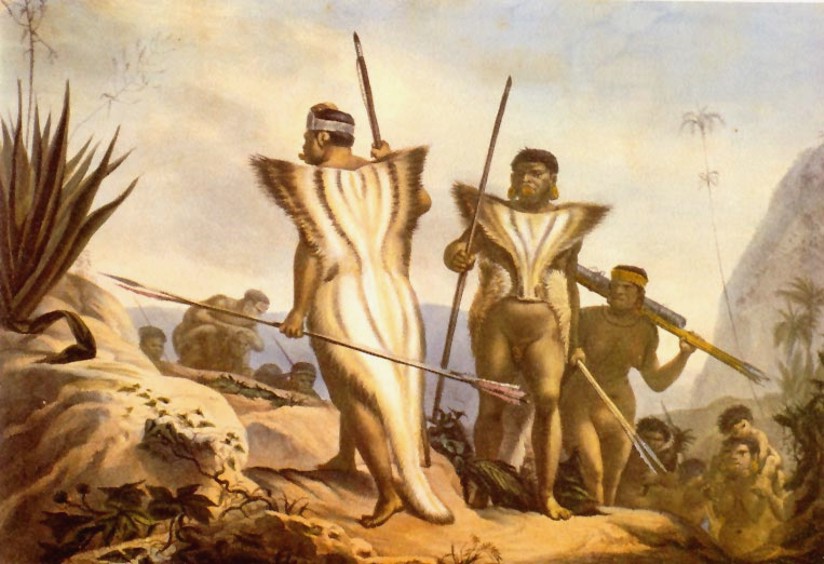 |
Late Mesopotamian history: Sumerians {now called Chaldeans}, who inhabited the coastal area of Sumer near the Persian Gulf, had never been entirely pacified by the Assyrians. Marduk-apla-iddina II (the biblical Merodach-Baladan - "Marduk has given me an Heir") (reigned 722 B.C. – 710 B.C.)( 703 B.C. – 702 B.C.) was a Chaldean prince who usurped the Babylonian throne in 721 B.C. He maintained Babylonian independence in the face of Assyrian military supremacy for more than a decade. Sargon II suppressed the allies of Marduk-apla-iddina II in Aram and Israel, and eventually drove him from Babylon in 710 B.C. After the death of Sargon II, Marduk-apla-iddina II returned from Elam and ignited all the Arameans in Babylon into rebellion. He was able to enter Babylon and be declared king again. Nine months later he was defeated near Kish, but escaped to Elam. He died in exile a couple of years later.
 |
 |
| Click for Realhistoryww Home Page |